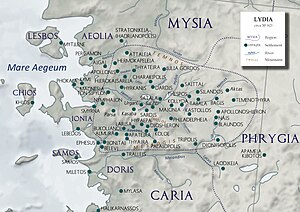
Nais was a town of ancient Lydia, inhabited during Roman times. [1]
Its site is located about one mile (1.6 km) south of İnay in Asiatic Turkey. [1] [2]

Nais was a town of ancient Lydia, inhabited during Roman times. [1]
Its site is located about one mile (1.6 km) south of İnay in Asiatic Turkey. [1] [2]
Maionia or Maeonia, was a city of the Hellenistic, Roman and Byzantine era located near the Hermos River, in ancient Lydia. Both Ramsay and Talbert tentatively identified the ancient polis with the modern village of Koula a village known for its carpet manufacture.
Metropolis was an ancient town in the southern part of Phrygia, belonging to the conventus of Apamea. That this town is different from the more northerly town of the name in northern Phrygia, is quite evident, even independently of the fact that Stephanus of Byzantium mentions two towns of the name of Metropolis in Phrygia, and that Hierocles. and the Notitiae speak of a town of this name in two different provinces of Phrygia. In Roman times, it was assigned to the province of Pisidia, where it became a bishopric. No longer a residential see, it remains, under the name Metropolis in Pisidia, a titular see of the Roman Catholic Church.
Achaion Limen was a port town of ancient Aeolis.
Pratomysia was a Roman town of ancient Bithynia. Its name does not occur in ancient authors but is inferred from epigraphic and other evidence.
Chelae or Chelai, also called Philemporos, was a town of ancient Thrace on the Bosphorus, inhabited during Roman and Byzantine times.
Otrus, or Otrous, was a town of ancient Phrygia located in the Phrygian Pentapolis, inhabited during Roman and Byzantine times.
Homadena was a town of ancient Phrygia on the road from Apamea to Eumeneia, inhabited during Roman and Byzantine times. Its name does not occur in ancient authors but is inferred from epigraphic and other evidence.

Temenothyra, or Temenothyrae or Temenothyrai, was a town of ancient Lydia, or of Phrygia, inhabited during Roman and Byzantine times. It became a bishopric; no longer the seat of a residential bishop, under the name Temenothyrae it remains a titular see of the Roman Catholic Church.
Taza was a town of ancient Lydia, inhabited during Roman times. Its name does not occur among ancient authors, but is inferred from epigraphic and other evidence.

Bonitai or Boneita was a town of ancient Lydia, near Ephesus, inhabited during Roman times.
Pissia was a town and bishopric of ancient Phrygia.
Dioskome was a town of ancient Phrygia, inhabited in Hellenistic, Roman, and Byzantine times.
Sebaste was a town of Phrygia Pacatiana in ancient Phrygia, inhabited in Roman and Byzantine times. It was located between Alydda and Eumenia. It became the seat of a Christian bishop, mentioned by Hierocles, and in the Acts of the Council of Constantinople, which its bishop attended. No longer a residential bishopric, it remains, under the name Sebaste in Phrygia, a titular see of the Roman Catholic Church.
Eibeos was a town of ancient Phrygia, inhabited in Roman and Byzantine times.
Clannuda or Klannouda was a town of ancient Phrygia, inhabited in Hellenistic, Roman, and Byzantine times. It was mentioned in the Peutinger Table as Clanudda, which places it 30 M.P. from Aludda and 35 M.P. from Philadelphia.
Kaualena was a town of ancient Phrygia, inhabited in Roman and Byzantine times. Its name does not occur in ancient authors, but is inferred from epigraphic and other evidence.
Panasion was a town of ancient Phrygia, inhabited in Roman and Byzantine times.
Kleros Politike was a town of ancient Phrygia, inhabited in Roman and Byzantine times.
Lankena was a town of ancient Phrygia, inhabited in Roman and Byzantine times. Its name does not occur in ancient authors, but is inferred from epigraphic and other evidence.
Cadi or Kadoi was a city of ancient Mysia according to Stephanus of Byzantium, or of Phrygia Epictetius according to Strabo. It was inhabited during Hellenistic, Roman, and Byzantine times. The coins of Cadi bear the ethnic name Καδοηνων; and the river Hermus is represented on them. Cadi may be the place which Propertius calls "Mygdonii Cadi." It was afterwards an episcopal see, in ecclesiastic province of Phrygia Pacatiana. No longer a residential bishopric, it remains a titular see of the Roman Catholic Church.
38°25′37″N29°12′41″E / 38.427036°N 29.211402°E